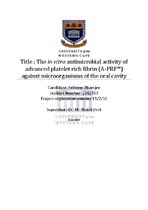| dc.contributor.advisor | Peck, M Thabit | |
| dc.contributor.author | Bhamjee, Feheem | |
| dc.date.accessioned | 2018-08-08T11:13:26Z | |
| dc.date.available | 2018-08-31T22:10:06Z | |
| dc.date.issued | 2017 | |
| dc.identifier.uri | http://hdl.handle.net/11394/6232 | |
| dc.description | Magister Chirurgiae Dentium - MChD (Oral Medicine and Periodontics) | |
| dc.description.abstract | In recent years, the development and use of autologous platelet rich concentrates (PC's) has
gained traction within the rapidly progressive, multidisciplinary field of regenerative
medicine. A PC subtype, marketed as advanced platelet rich fibrin (A- PRF), is a recent
advancement of the original PRF protocol and promoted as a "blood concentrate"
containing platelets, leukocytes, circulating stem cells and endothelial cells. A-PRF in the
form of membranes, plugs, or even shredded particulates are increasingly being used as
surgical adjuncts in areas of previous infection or left exposed within the microbial rich oral
environment. Although recent literature has noted the biologic benefits of this material
within the context of wound healing and regeneration, the antimicrobial potential of APRF
has remained unexplored. The aim of this investigation is to determine if A-PRF
displays antimicrobial activity against microbes of the oral cavity with a null hypothesis that
its activity is no different to a clot of unprocessed venous blood.
Methodology: A-PRF and whole blood samples were obtained from consenting individuals
and utilised to conduct an in-vitro agar disk diffusion investigation to determine their
antimicrobial activity. Standardised samples of A-PRF, unprocessed clotted blood and 0.2%
chlorhexidine gluconate (CHX) were tested against organisms cultured from fresh oral rinse
samples and pure cultures of candida albicans, streptococcus mutans, staphylococcus
aureus and enterococcus faecalis. The antimicrobial activity was assessed in accordance to
the established principles of the agar disk diffusion method and measurement of inhibition
zones.
Results: A-PRF displayed antimicrobial activity against all of the individual organisms
tested within this study following a 24 hour incubation period. However, no significant
differences were noted between A-PRF and a natural clot of blood when tested against
cultures of the oral rinse sample. Finally, the antimicrobial activity of A-PRF is significantly
inferior to an equal volume of the CHX preparation.
Conclusion: Although A-PRF displays antimicrobial activity; its strength, spectrum and
biologic activity within a polymicrobial environment requires further investigation. | |
| dc.language.iso | en | |
| dc.publisher | University of the Western Cape | |
| dc.subject | Antimicrobial, Platelet concentrates, Platelet Rich Fibrin, Bacteria, Surgery, Blood, Chlorhexidine, Growth factors, Serum, A-PRF | |
| dc.title | The in vitro antimicrobial activity of
advanced platelet rich fibrin (A-PRF)
against microorganisms of the oral cavity | |
| dc.rights.holder | University of the Western Cape | |

